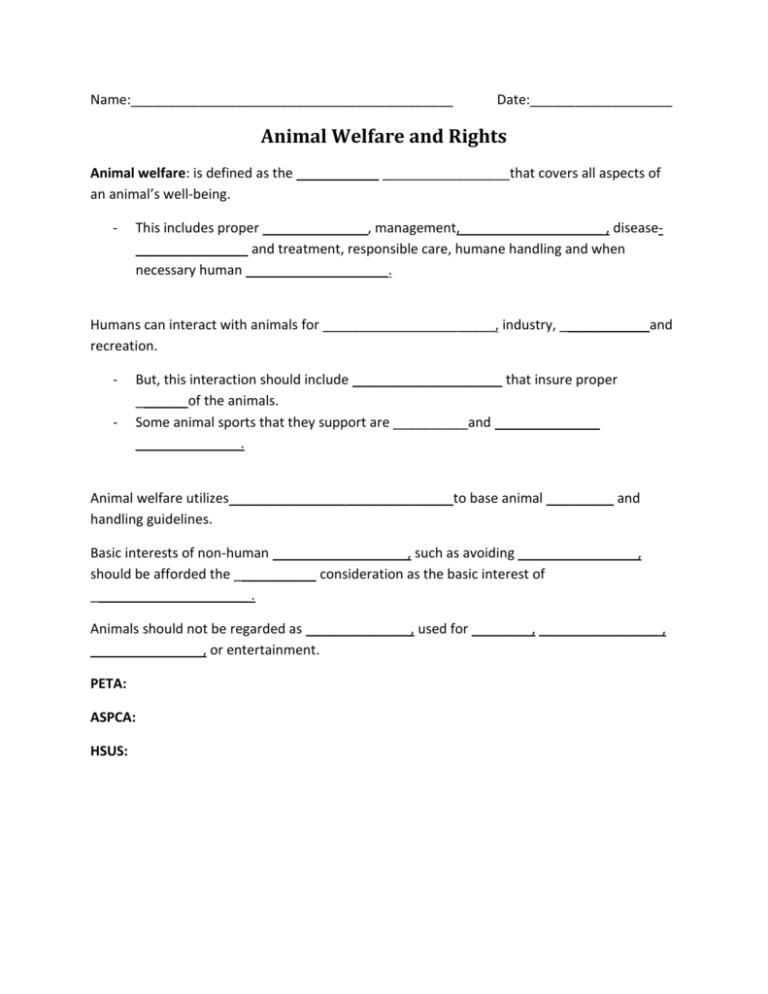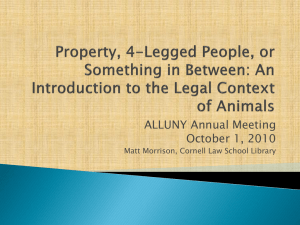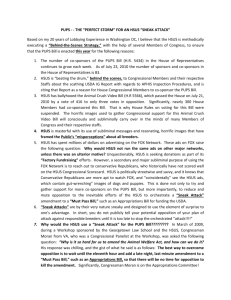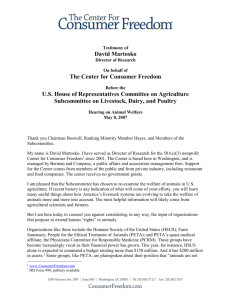Animal Rights Worksheet - Montgomery County Schools
advertisement

Name:___________________________________________ Date:___________________ Animal Welfare and Rights Animal welfare: is defined as the ___________ _________________that covers all aspects of an animal’s well-being. - This includes proper ______________, management,___________________ , disease_______________ and treatment, responsible care, humane handling and when necessary human ___________________. Humans can interact with animals for _______________________, industry, ____________and recreation. - But, this interaction should include ____________________ that insure proper _______of the animals. Some animal sports that they support are __________and ______________ ______________. Animal welfare utilizes _______________ ______________to base animal _________ and handling guidelines. Basic interests of non-human __________________, such as avoiding ________________, should be afforded the ___________ consideration as the basic interest of _____________________ . Animals should not be regarded as ______________, used for ________, ________________ , _______________, or entertainment. PETA: ASPCA: HSUS: HSUS Pet Overpopulation Estimates The Humane Society of the United States Estimated number of cats and dogs entering shelters each year: 6-8 million (HSUS estimate) Estimated number of cats and dogs euthanized by shelters each year: 3-4 million (HSUS estimate) Estimated number of cats and dogs adopted from shelters each year: 3-4 million (HSUS estimate) Estimated number of cats and dogs reclaimed by owners from shelters each year: 30 percent of dogs and 2-5 percent of cats entering shelters (HSUS estimate) Estimated number of animal shelters in the United States: 3,500 (HSUS estimate) Estimated percent of dogs in shelters who are purebred: 25 percent (HSUS estimate) Unless otherwise indicated, statistics provided by The National Council on Pet Population, Study and Policy. Animal Cruelty Facts and Statistics Statistics on the victims and current legislative trends Continuous chaining is illegal in some parts of the country, and cruel everywhere. iStockphoto The shocking number of cruelty cases reported daily in the media is only the tip of the iceberg. Most cases are never reported, and most animal suffering goes unrecognized and unabated. Although there is no national reporting system for animal abuse, media reports suggest that it is common in rural and urban areas. Cruelty and neglect can also cross socio-economic boundaries. Based on media reports, we can review animal cruelty in terms of: Most common victims Horses Livestock Domestic violence Legislative trends Unless otherwise noted, the following statistics are compiled from pet-abuse.com. Most Common Victims In media-reported animal cruelty cases, dogs—and pit bull-type dogs, in particular—are the most common victims of animal cruelty. Of 1,880 cruelty cases* reported in the media in 2007: 64.5% (1,212) involved dogs 18% (337) involved cats 25% (470) involved other animals Reported abuse against pit bull-type dogs appears to be on the rise: in 2000–2001, pit bull-type dogs were involved in 13% of reported dog-abuse cases; in 2007, they were involved in 25% of reported dogabuse cases. *some cases involved multiple species Horses According to the American Horse Council, Americans own more than 9 million horses, up from more than 6 million in the mid-1990s. Backyard breeding fueled the boom in pet horses. Of the more than 2 million Americans who own horses, more than one-third have a household income of less than $50,000. [1] Neither the total number of horse neglect cases nor the percentage of total animal abuse cases classified as horse neglect has risen since the closure of all U.S. horse slaughter plants. Livestock As HSUS investigations into slaughterhouses and cattle auctions have revealed, animal abuse abounds in the factory farm industry. Despite increased feed prices, we found no indication in the news media that the number of livestock neglect cases is increasing, other than a few shocking, high-profile cases. This may, however, simply be a reflection of the weak protections afforded to livestock under state animal cruelty laws. Many states specifically exclude livestock or any "common" agricultural practices from their cruelty laws, and even when good laws exist, it can sometimes be difficult to convince law enforcement to make an arrest and/or to seize livestock who are being neglected or abused. Over the past few years, the number of reported animal neglect cases involving cows and pigs has dipped slightly. In 2007, there were 20 reported neglect cases involving cows and eight involving pigs, down from 33 cow neglect cases and 11 pig neglect cases in 2006, and 26 cow neglect cases and nine pig neglect cases in 2005. Domestic Violence Government data scholarly studies of the prevalence of animal cruelty in domestic violence cases reveals a staggering number of animals are victimized by abusive partners each year. The HSUS estimates that nearly 1 million animals a year are abused or killed in connection with domestic violence. Statistics: About 2,168,000 women and men are physically assaulted by an intimate partner in the U.S. every year (U.S. Department of Justice, 2000). 63% of U.S. households own a pet (APPMA, 2006). 71% of domestic violence victims report that their abuser also targeted their animal (Ascione, 1997). In 2007, 7% of media-reported animal cruelty cases either occured in the context of a domestic dispute or involved a person with a history of domestic violence. Legislative Trends 47 states currently have felony provisions for animal cruelty. (Those without are Idaho, North Dakota, and South Dakota.) Before 1986, only four states had felony animal cruelty laws. 42 of the 47 state felony animal cruelty laws were enacted in the last three decades: 13 were enacted between 1986 and 1996, and 28 more were enacted between 1997 and 2011







